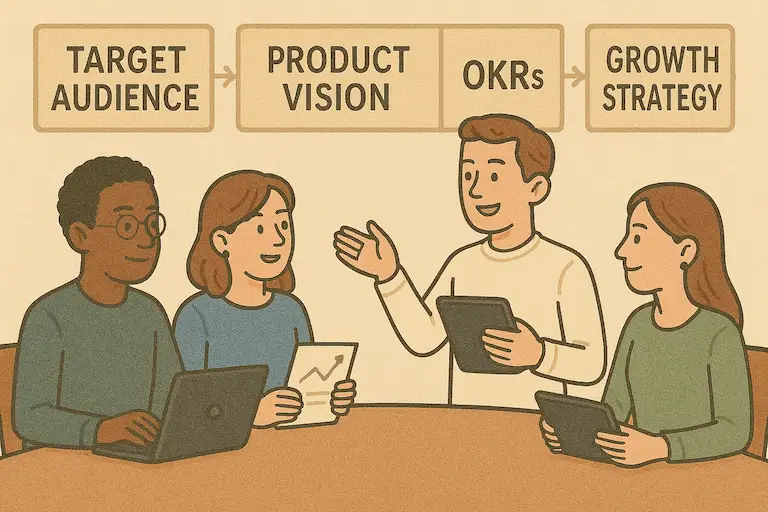What is digital product strategy?
Digital product strategy is the roadmap that defines why your digital product exists, who it creates value for, and how it will grow in the future. In simple terms, it’s the plan to deliver the right product to the right user at the right time.
In other words, it’s about bringing the product vision to life and aligning it with business goals.
Items that can be included in the product strategy
Here are key areas that may be part of a digital product strategy:
- Defining Target Audience and Personas
- Value Proposition
- Market Analysis and Competitor Review
- Product Vision and Mission
- Measurable Goals (OKRs, KPIs)
- User Journeys
- Pricing and Revenue Model
- Technology and Platform Selection
- Growth Strategy
- Sustainability and Compliance
Additionally, including these items ensures a holistic and future-proof strategy.
Digital product strategy purpose and importance
A strong product strategy brings many benefits:
- First, it brings focus: Everyone understands why the product exists and where it’s headed.
- Moreover, it simplifies decisions: From feature selection to marketing tactics, everything becomes clearer.
- Furthermore, it aligns stakeholders: Product, business, and technical teams unite around a shared vision.
- Finally, it makes success measurable: You can set clear goals to define success.
Simply put, It answers the question, “Where is the product going?”
How digital product strategy works or is applied
Generally, the process follows these key steps:
- Identify target users and their problems.
- Conduct market and competitor analysis.
- Clarify the product’s value proposition.
- Set short, medium, and long-term goals.
- Plan which features to build and when.
- Define success metrics.
- Establish a continuous test-and-learn cycle.
As a result, this strategy should stay flexible and adapt to new insights.
Related concepts
Here are some concepts closely connected to digital product strategy:
- Product Roadmap → Derived from the strategy; it’s the execution plan.
- Marketing Strategy → Explains how the product will be promoted and sold.
- Product Vision → The high-level and inspiring expression of the strategy.
- Growth Strategy → Focuses on user acquisition and retention.
However, remember that strategy is not just about “setting goals.” (WRONG). In reality, it shows how to achieve them.
Tips to keep your product strategy relevant
- Stay user-focused. Prioritize user needs over personal ideas.
- Keep it simple and clear. Use language everyone can understand.
- Be flexible. Allow the strategy to evolve through learning and adaptation.
- Make data-driven decisions. Rely on insights, not just instincts.
- Share with all stakeholders. Don’t keep the strategy behind closed doors.
Ultimately, the strategy should serve as a guiding compass for the entire team.
Common product strategy myths (and the truth)
❗Myth: Strategy is done once and forgotten.
Truth: It should be updated continuously.
❗Myth: Strategy is only for leaders.
Truth: It creates shared understanding for the whole team.
❗Myth: Strategy is just about setting goals.
Truth: It answers what, why, and how.
❗Myth: Copying competitors is strategy.
Truth: Strategy is about creating differentiation.
Real product strategy examples in action
Here are some real-world examples:
- Mission: Make music accessible to everyone.
- Strategy: Grow by turning free users into premium subscribers through personalized playlists and social features.
- Mission: Offer authentic travel experiences.
- Strategy: Build community-focused solutions that make hosts and guests feel safe.
- Problem: Small businesses face complex invoicing processes.
- Strategy: Focus on this audience with a simple self-service interface and affordable subscription plans.
In each case, strategy guided clear, actionable decisions.
Product Guiding Resources
- Creating Digital Product Strategies That Actually Work
- Why Every Digital Product Manager Needs a Clear Strategy
Summary and reminder
Digital product strategy = The plan for where, why, and how we’ll move forward
Target → Who and what we’re aiming for
Path → How we’ll get there
Flexibility → Learn and update regularly
In conclusion, when strategy becomes a living, shared part of the team, your product becomes not just functional, but also meaningful and sustainable.
